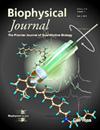α -突触核蛋白纤维结构聚集成不同的类
IF 3.2
3区 生物学
Q2 BIOPHYSICS
引用次数: 0
摘要
α -突触核蛋白(Asyn)原纤维的积累是帕金森病(PD)、路易体痴呆(LBD)和多系统萎缩(MSA)的典型病理特征。因此,非对称原纤维的形成过程一直是一个重要的研究领域,原纤维本身也成为疾病诊断和治疗干预的有吸引力的靶点。由于与脑组织中神经退行性疾病相关的纤维蛋白混合种群的存在,因此Asyn原纤维的高分辨率结构对于设计高特异性成像和治疗剂至关重要。大约100个高分辨率固态核磁共振(SSNMR)光谱和低温电子显微镜(cryo-EM)结构的Asyn原纤维已被存入蛋白质数据库(PDB);有趣的是,它们之间存在显著的多态性。了解每个结构多态性的分子组成和特征可以确定保守的结构基序,这些结构基序可以作为模板设计具有高特异性的配体供临床使用。利用标准的排列工具和基于密度的聚类方法,我们客观地根据三级结构类型对纤维结构进行分类。我们发现84%的结构聚集成两个多晶类。在每一类中,观察到额外的微妙变化,这些变化将侧链定位在特定的、保守的方向上,很好地定位为可药物靶标。此外,我们发现与每一类相关的保守结构基序在所有已发表的非对称原纤维结构中都有发现。我们在疾病相关原纤维结构的背景下考虑这些分类和保守基序,并提供了体外原纤维作为药物开发底物和疾病发病机制模型的应用前景。本文章由计算机程序翻译,如有差异,请以英文原文为准。
Alpha-Synuclein Fibril Structures Cluster into Distinct Classes
The accumulation of Alpha-synuclein (Asyn) fibrils is the defining pathologic feature in Parkinson Disease (PD), Lewy Body Dementia (LBD), and Multiple System Atrophy (MSA). As such, the process of Asyn fibril formation has been an important research area and fibrils themselves have become attractive targets for disease diagnosis and therapeutic intervention. Due to the presence of mixed populations of fibrillar proteins associated with neurodegenerative diseases in brain tissue, high-resolution structures of Asyn fibrils are essential for the design of high-specificity imaging and therapeutic agents. Approximately one hundred high-resolution solid-state NMR (SSNMR) spectroscopy and cryo-electron microscopy (cryo-EM) structures of Asyn fibrils have been deposited to the Protein Databank (PDB); intriguingly there is significant polymorphism among them. Understanding the molecular makeup and characteristic features of each structural polymorph can determine conserved structural motifs which can be used as templates to design ligands with high specificity for clinical use. Utilizing standard alignment tools and density-based clustering approaches, we objectively classify fibril structures by tertiary structure type. We find that 84% of the structures cluster into two polymorph classes. Within each class, additional subtle variations are observed which position sidechains in specific, conserved orientations, well poised as druggable targets. Furthermore, we find that the conserved structural motifs associated with each class are found in all but one published Asyn fibril structure. We consider these classifications and conserved motifs in the context of disease-relevant fibril structures and offer a perspective on the utility of in vitro fibrils as substrates for drug development and models for disease pathogenesis.
求助全文
通过发布文献求助,成功后即可免费获取论文全文。
去求助
来源期刊

Biophysical journal
生物-生物物理
CiteScore
6.10
自引率
5.90%
发文量
3090
审稿时长
2 months
期刊介绍:
BJ publishes original articles, letters, and perspectives on important problems in modern biophysics. The papers should be written so as to be of interest to a broad community of biophysicists. BJ welcomes experimental studies that employ quantitative physical approaches for the study of biological systems, including or spanning scales from molecule to whole organism. Experimental studies of a purely descriptive or phenomenological nature, with no theoretical or mechanistic underpinning, are not appropriate for publication in BJ. Theoretical studies should offer new insights into the understanding ofexperimental results or suggest new experimentally testable hypotheses. Articles reporting significant methodological or technological advances, which have potential to open new areas of biophysical investigation, are also suitable for publication in BJ. Papers describing improvements in accuracy or speed of existing methods or extra detail within methods described previously are not suitable for BJ.
 求助内容:
求助内容: 应助结果提醒方式:
应助结果提醒方式:


